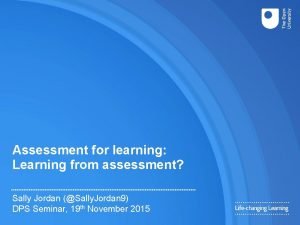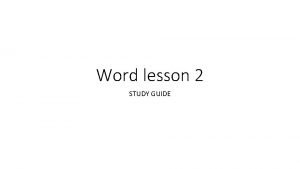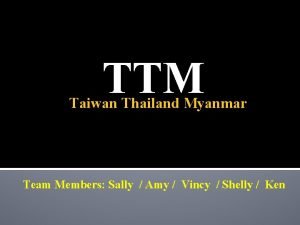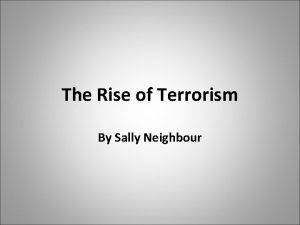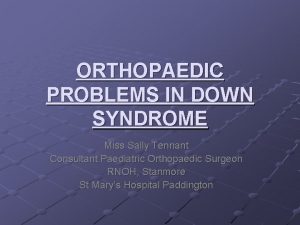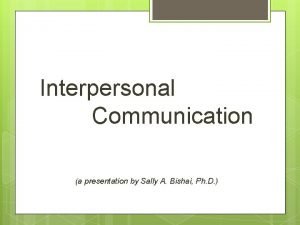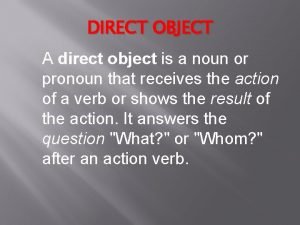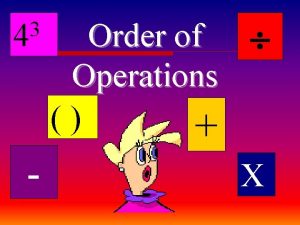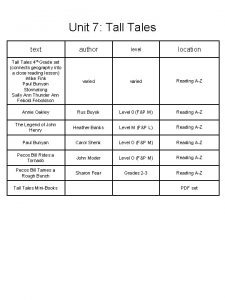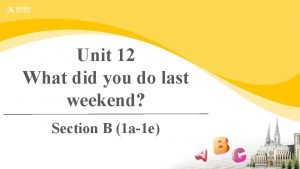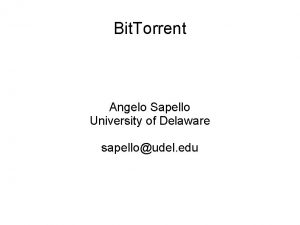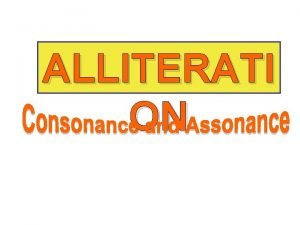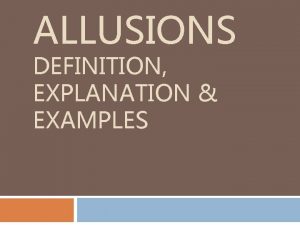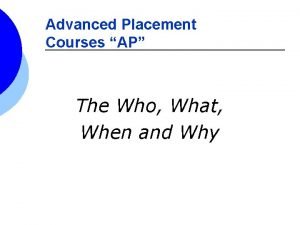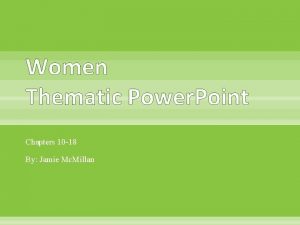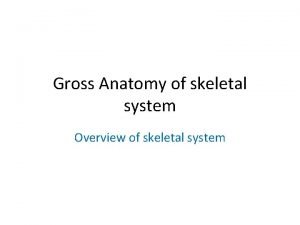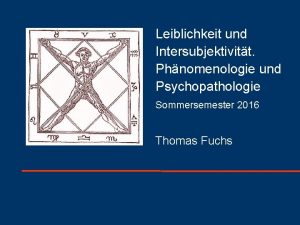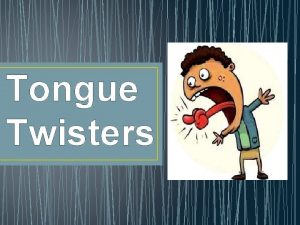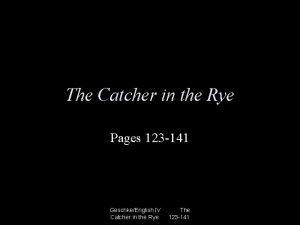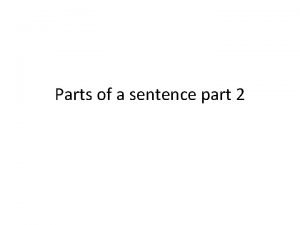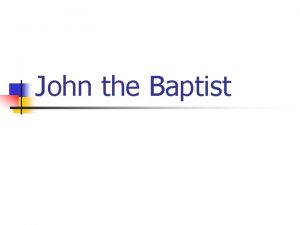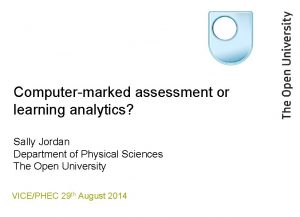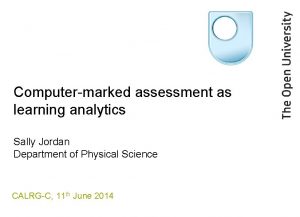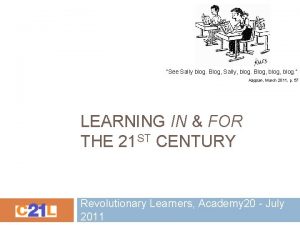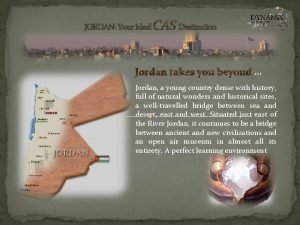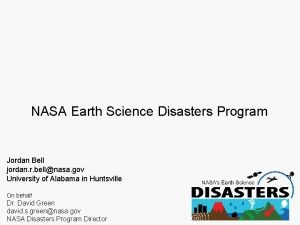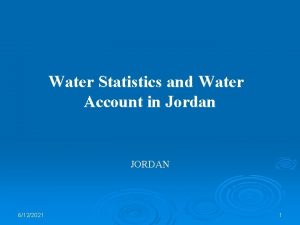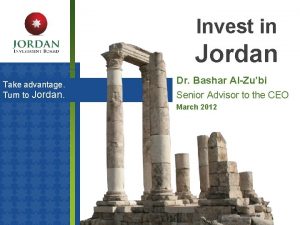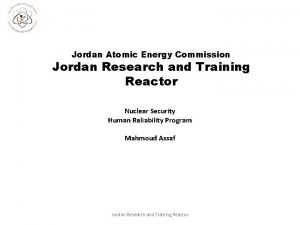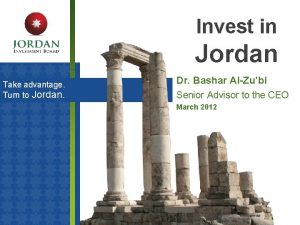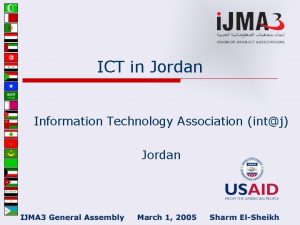Assessment for learning Learning from assessment Sally Jordan













































- Slides: 45

Assessment for learning: Learning from assessment? Sally Jordan (@Sally. Jordan 9) DPS Seminar, 19 th November 2015

My background ● Longstanding interests in assessment and maths skills development; ● Introduced online interactive assessment into S 151 Maths for Science (2002); ● Several CETL and other externally-funded projects in particular: ● Project which investigated the use of short-answer freetext questions; ● “Remote observation” of student engagement with eassessment; ● I am passionate about using scientific methodology to find out what is going on in learning.

Why have I used computer-marked assessment? • In my work, the focus has been on ‘assessment for learning’, so feedback and giving students a second and third attempt is important (Gibbs & Simpson, 2004 -5). • We aim to ‘provide a tutor at the student’s elbow’ (Ross et al. , 2006). • My work has been at the limit of what is possible with computer-marked assessment (not just multiple-choice questions!). • …to learn more about what is going on…[Learning analytics/assessment analytics]

Analysis of student errors ● At the most basic – look for questions that students struggle with; ● Look at responses in more detail to learn more about the errors that students make; ● This can give insight into student misunderstandings. ● So what topics in Maths for Science do students find difficult?

So what topics in Maths for Science do students find difficult?

Analysis of student responses to individual questions Gives information about student errors, linked to their misconceptions. The confidence in the findings is increased when • The questions require a ‘free-text’ (constructed) response; • The questions are in summative use (students are trying); • Similar errors are seen in different variants. See Jordan (2014)

Why is the answer 243? (instead of 9) The question was: Evaluate 36/3 7

Why is the answer 243? (instead of 9) The question was: Evaluate 36/3 Students were evaluating Instead of 36/3 = 32 = 9

For another variant the answer was 5000 instead of 100 The question was: Evaluate 104/2 Students were evaluating Instead of 104/2 = 100 9

Measuring student engagement… “ 750 students used my i. CMA”

Measuring student engagement…

Measuring student engagement…

When do students do i. CMAs? (overall activity)

When do students do i. CMAs? (impact of deadlines)

When do students do i. CMAs (typical patterns of use)

Student engagement with feedback

Student engagement with feedback (identical question) Module A Module B

General conclusions ●Analysis of student responses to interactive computer-marked questions can give information about student misunderstandings and student engagement with assessment; ●Generally, students do what they believe their teachers expect them to do; ●Engagement with computer-marked assessment can act as a proxy for more general engagement with a module (and so act as an early warning if engagement is not as deep as we might wish).

The future? ● Redecker, Punie and Ferrari (2012, p. 302) suggest that we should “transcend the testing paradigm”; data collected from student interaction in an online environment offers the possibility to assess students on their actual interactions rather than adding assessment separately.

A short-answer question (PMatch) https: //students. open. ac. uk/openmark/s 104 -11 b. icma 48/

A short-answer question (PMatch)

A short-answer question (PMatch)

Short-answer free-text questions: humancomputer marking comparison ●A linguistically-based system was used to mark and give feedback on student responses of ‘a sentence’ in length. ●The computer marking was compared with that of 6 human markers.

Question Number of responses in analysis Percentage of responses where the human markers were in agreement with question author Range for the 6 human markers Mean percentage for the 6 human markers Percentage of responses where computer marking was in agreement with question author A 189 97. 4 to 100 98. 9 99. 5 B 248 83. 9 to 97. 2 91. 9 97. 6 C 150 80. 7 to 94. 0 86. 9 94. 7 D 129 91. 5 to 98. 4 96. 7 97. 6 E 92 92. 4 to 97. 8 95. 1 98. 9 F 129 86. 0 to 97. 7 90. 8 97. 7 G 132 66. 7 to 90. 2 83. 2 89. 4

Short-answer free-text questions: computer marking comparison ●An undergraduate student (not of computer science) developed answer matching using two algorithmically based systems, Java regular expressions and Open. Mark PMatch; ●These are not simple ‘bag of words’ systems; ●Student responses were used in the development of the answer matching, as had been the case for the linguistically based IAT system; ●The results were compared.

Question Responses in set Percentage of responses where computer marking was in agreement with question author Computational linguistics Algorithmic manipulation of keywords IAT Open. Mark Regular Expressions A 189 99. 5 98. 9 B 248 97. 6 98. 8 98. 0 C 150 94. 7 90. 7 D 129 97. 6 96. 1 97. 7 E 92 98. 9 96. 7 F 129 97. 7 88. 4 89. 2 G 132 89. 4 87. 9 88. 6

Word-length for Snowflake question ●With no restriction on the number of words allowed 1

Word-length for Snowflake question ●With warning ‘Your answer should be no more than 20 words in length. ’ 1

Word-length for Snowflake question ●With warning ‘Your answer should be no more than 20 words in length. ’ 1

Exploring the gender gap ● S 207 (The Physical World) was a 60 -credit OU level 2 (FHEQ level 5) module (replaced by S 217 from autumn 2015). ● Men were significantly and consistently more likely to complete S 207 than women. ● Of those who complete, men were more likely to pass. ● The difference in outcomes was larger in 2013 -14. ● The effect is not present in our level 1 modules or in any other Science level 2 modules except for S 282 (Astronomy), where women also do less well but the difference is not so stark. ● Women do slightly better on our level 3 physical science modules. 30

So what’s causing the attainment gap? Initial hypotheses: ● It has something to do with the type of assessment we are using. ● There are other demographic differences (e. g. previous educational qualifications) between our male and female students. ● There are other differences between men and women e. g. in the amount of time they have available for study. ● It has something to do with role models and/or the nature of the support being offered. ● It has something more fundamental to do with the way we are teaching physics. ● On average, women and men handle certain physical concepts and skills of physics in a different way. 31

Results of data analysis Concentrating on the 2013 -14 presentation N (male) = 455 N (female) = 157 32

Different outcomes for male and female students 33

When do students stop submitting assignments? 34

Performance on different parts of the exam Part A is multiple-choice questions; Part B is short-answer questions; Part C is longer questions (with choice) 35

Performance on different questions in the exam For Part C (Choice of 3 out of 7 long questions) 36

Choice of different questions in the exam For Part C (Choice of 3 out of 7 long questions) 37

Performance on i. CMAs (interactive computer-marked assignments) Note that a wide range of questions are represented, but there is no obvious correlation between male/female performance and question type. 38

Demographics § There are no obvious differences between the distribution of other demographic factors (e. g. age, previous educational qualifications etc. ) for men and women. § However, there is some indication that women with other characteristics, in particular o having less than two A levels o not having English as a first language may be particularly likely to withdraw. § There is also some evidence that women appreciate different aspects of student support/tuition than men. § Although the proportion of students with A levels is similar for men and women, we don’t know how many have A levels in maths and physics. 39

Summary and some questions ● We have a significant attainment gap between men and women on our level 2 physics module; we have ruled out many possible explanations but further investigation is of vital importance. ● Block 2 (Describing motion) and Block 3 (Predicting motion) may be creating particular problems. ● Particular questions (not question types) may be causing particular problems. ● We know that most girls who do maths and physics A level go straight to University; does this mean that the female OU population has a relatively smaller proportion of students with A levels in maths and/or physics? ● Our level 1 modules prepare students for the content of S 207/S 217, but do they prepare students for the question types? ● Are our teaching materials and questions sufficiently clear for students for whom English is not their first language? ● Women appear to be more likely to give up if they are finding the module difficult. Is this because they have a different motivation for student/less time/less confidence? 40

What next? Your thoughts and suggestions please ● S 217 has a different tuition and assessment strategy – review the impact ● Surveying (male and female) students to find out more detail about their previous qualifications, whether they consider English to be their first language, and their perception of their preparedness to study S 207/S 217. ● Work with a statistician to model which demographic factors may be combining to contribute to success or the lack of it – for all students and across several universities ● Combine the work with another project that is using free-text questions to establish the “Force concept inventory” 41

References Clow, D. (2013). An overview of learning analytics. Teaching in Higher Education, 18(6), 683 -695. Ellis, C. (2013). Broadening the scope and increasing the usefulness of learning analytics: The case for assessment analytics. British Journal of Educational Technology, 44(4), 662664. Nicol, D. & Macfarlane‐Dick, D. (2006). Formative assessment and self‐regulated learning: a model and seven principles of good feedback practice. Studies in Higher Education, 31(2), 199 -218. Redecker, C. , Punie, Y. , & Ferrari, A. (2012). e. Assessment for 21 st Century Learning and Skills. In A. Ravenscroft, S. Lindstaedt, C. D. Kloos & D. Hernandez-Leo (Eds. ), 21 st Century Learning for 21 st Century Skills (pp. 292 -305). Berlin: Springer.

For more about what I’ve discussed Jordan, S. (2011). Using interactive computer-based assessment to support beginning distance learners of science, Open Learning, 26(2), 147 -164. Jordan, S. (2012). Student engagement with assessment and feedback: Some lessons from short-answer free-text eassessment questions. Computers & Education, 58(2), 818 -834. Jordan, S. (2013). Using e-assessment to learn about learning. In Proceedings of the 2013 International Computer Assisted Assessment (CAA) Conference, Southampton, 9 th-10 th July 2013. Retrieved from http: //caaconference. co. uk/proceedings/ Jordan, S. (2014). Adult science learners’ mathematical mistakes: an analysis of student responses to computer-marked questions. European Journal of Science and Mathematics Education, 2(2), 63 -87.

For more on OU e-assessment systems Butcher, P. G. (2008). Online assessment at the Open University using open source software: Moodle, Open. Mark and more. In Proceedings of the 12 th International Computer Assisted (CAA) Conference, Loughborough, 8 th-9 th July 2008. Retrieved from http: //caaconference. co. uk/past. Conferences/2008/proceedings Hunt, T. J. (2012). Computer-marked assessment in Moodle: Past, present and future. In Proceedings of the 2012 International Computer Assisted Assessment (CAA) Conference, Southampton, 10 th-11 th July 2012. Retrieved from http: //caaconference. co. uk/proceedings/ Ross, S. M. , Jordan, S. E. & Butcher, P. G. (2006). Online instantaneous and targeted feedback for remote learners. In C. Bryan & K. Clegg (Eds. ), Innovative Assessment in Higher Education (pp. 123 -131). London: Routledge. Sangwin, C. J. (2013). Computer aided assessment of mathematics. Oxford: Oxford University Press. Much of what I have said is discussed in more detail in: Jordan, S. E. (2014). E-assessment for learning? Exploring the potential of computer-marked assessment and computer-generated feedback, from shortanswer questions to assessment analytics. Ph. D thesis. The Open University. Retrieved from http: //oro. open. ac. uk/4111

Sally Jordan email: sally. jordan@open. ac. uk twitter: @Sally. Jordan 9 blog: http: //www. open. ac. uk/blogs/Sally. Jordan/
 Sally jordan model
Sally jordan model Sally wants to select an entire paragraph
Sally wants to select an entire paragraph Sally ts menu
Sally ts menu Sally neighbour education
Sally neighbour education Sally durant level 4
Sally durant level 4 Sally and her family
Sally and her family Sally tennant orthopaedic
Sally tennant orthopaedic Lily collins 2014
Lily collins 2014 Sally nitm
Sally nitm Business agility metrics
Business agility metrics Please excuse my dear aunt sally
Please excuse my dear aunt sally Direct object noun
Direct object noun Please excuse my dear aunt sally
Please excuse my dear aunt sally Davy crockett tall tale pdf
Davy crockett tall tale pdf What did you do last friday
What did you do last friday What makes holden sad when he thinks about the nuns?
What makes holden sad when he thinks about the nuns? Sally reardon
Sally reardon Sally guzman edmonds school district
Sally guzman edmonds school district What wise thing did darius say
What wise thing did darius say Sally neuberger
Sally neuberger Sally d'angelo torrent
Sally d'angelo torrent Alliterati
Alliterati Sally manke
Sally manke Re-aim
Re-aim Sally elatta
Sally elatta Sally dickerson
Sally dickerson Eumetazoa
Eumetazoa Allusion definition and examples
Allusion definition and examples Umich ap exam credit
Umich ap exam credit Sally tompkins
Sally tompkins Brian lannin
Brian lannin Sally likes
Sally likes Grab some paper
Grab some paper Sally trembath psychologist
Sally trembath psychologist Sally
Sally Sally is the girl with eyes like egypt
Sally is the girl with eyes like egypt Sally puzey
Sally puzey Sally left the party to take cathy home
Sally left the party to take cathy home Sally dickinson fao
Sally dickinson fao Sally–anne test
Sally–anne test Sally–anne test
Sally–anne test Chester cheetah chewed a chunk of cheap cheddar cheese
Chester cheetah chewed a chunk of cheap cheddar cheese Sally equation
Sally equation Sally hayes catcher in the rye
Sally hayes catcher in the rye Sally hanley
Sally hanley Sally (run, runs) to the park every day
Sally (run, runs) to the park every day
